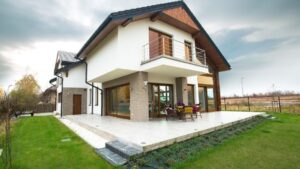In recent years, tiny houses have emerged as a popular alternative to traditional housing.
Embraced by minimalists, adventurers, and those looking to simplify, tiny houses offer a compact lifestyle with many appealing benefits. However, downsizing to such a small space comes with challenges and may not suit everyone.
Understanding the pros and cons of tiny houses can help you decide if this lifestyle aligns with your personal goals, budget, and long-term vision.
Tiny Houses and the Concept of Small Living
A tiny house generally ranges from 100 to 400 square feet, offering a compact, efficient living space that prioritizes functionality over luxury.
Popularized by the minimalist movement and eco-conscious individuals, tiny houses offer an opportunity to reduce environmental impact, cut costs, and lead a simpler life.
But, beyond the appeal of small living, the reality of living in a tiny house requires significant lifestyle adjustments.
Here, we explore the advantages and potential drawbacks of tiny homes to help you decide if this choice is right for you.
Pros of Tiny House Living
1. Less Clutter, More Freedom
With less space, you simply can’t collect as much stuff. And for many, that’s a good thing. A tiny house forces you to be selective about what you own, and that can bring a real sense of freedom. Goodbye cluttered closets and random junk drawers! According to a study by Princeton University, clutter can negatively impact your mental well-being. A tiny house keeps clutter in check, which might just help clear your mind, too.
2. Lower Costs
Tiny houses usually cost a lot less than traditional homes. Not only are the building or purchase costs lower, but so are the utility bills. Think about it: with a smaller space to heat, cool, and maintain, you could save big money. The average tiny house costs about $30,000 to $60,000, compared to the median price of a regular home—which is now well over $300,000. That’s a huge difference.
3. Environmentally Friendly
Tiny homes have a smaller environmental footprint. They use fewer materials to build, and their smaller space means less energy consumption. If you’re looking to reduce your carbon footprint, a tiny house might be an appealing option. Many tiny homeowners also incorporate solar panels, composting toilets, and rainwater collection to go even greener.
4. Easier Maintenance
Cleaning a tiny home is a breeze. Imagine how quickly you could vacuum or dust when you only have a couple of hundred square feet to deal with! The maintenance of a tiny house is also simpler—fewer windows to wash, less roof area to repair, and less everything overall. Less time spent maintaining means more time doing what you love.
5. Mobility
Many tiny houses are built on trailers, making it possible to move whenever you feel like it. If you have wanderlust, this could be a great benefit. Want to live by the beach in the summer and near the mountains in the winter? A tiny house on wheels can help make that happen.
Cons of Tiny House Living
1. Limited Space
Let’s be real—space is tight. For some people, the limited space can be very restricting. If you’re someone who likes hosting big gatherings or needs a lot of personal room, tiny house living could feel suffocating. Storage becomes a major challenge, and finding space for hobbies, guests, or even just stretching out might be difficult.
2. Zoning Regulations
Tiny houses can face zoning challenges, depending on where you live. Many cities have strict regulations regarding minimum square footage or prohibit tiny homes altogether. This can make finding a legal place to park or build your tiny house tricky. Before committing to a tiny home, it’s essential to research local zoning laws.
3. Privacy Issues
Living in such close quarters means that privacy can be hard to come by. If you live alone, this might not be an issue. But for couples or families, the lack of space could lead to a lack of personal boundaries. You’re always right there—and so is everyone else. If you like having space to yourself, a tiny house might be too cramped for comfort.
4. Weather and Climate Considerations
Heating or cooling a tiny house can be tricky, especially if you live in an area with extreme temperatures. Tiny homes can get chilly in the winter or sweltering in the summer if not properly insulated. Since there’s not much room, finding the perfect balance can be harder compared to a larger house where airflow is easier to manage.
5. Resale Value
While tiny houses are getting more popular, their resale value is still uncertain. Traditional homes tend to appreciate over time, but tiny homes might not offer the same investment return. It’s a more niche market, and finding the right buyer could take some time.
Is Tiny House Living Right for You?
Tiny house living definitely isn’t for everyone, but it might be perfect for you if:
- You’re looking to minimize your lifestyle and live more simply.
- You don’t mind parting with most of your possessions.
- You’re excited about lowering your expenses and reducing your environmental footprint.
- You value mobility and have an adventurous spirit.
However, if you like your space, need room for a growing family, or aren’t ready to deal with zoning complications, a tiny house could end up being more trouble than it’s worth.
FAQs
What is the average cost of a tiny house?
The cost varies widely, from $30,000 to $100,000, depending on size, materials, and customization.
Are tiny houses legal everywhere?
No, zoning laws vary, so it’s crucial to research local regulations to find legal places to park or build a tiny house.
Can families live comfortably in a tiny house?
While challenging, some families do successfully adapt to tiny living, often with custom designs and creative storage solutions.
How do tiny homes handle extreme weather?
Many tiny houses are well-insulated, but mobile tiny homes may face issues in severe weather conditions, so planning for insulation and climate control is essential.
Can I finance a tiny house?
Financing is available but can be limited, with many banks offering RV loans rather than traditional mortgages for tiny homes.
What are common materials used in tiny house construction?
Tiny homes can be built from various materials, including wood, steel, and eco-friendly options like reclaimed wood and recycled metal.










